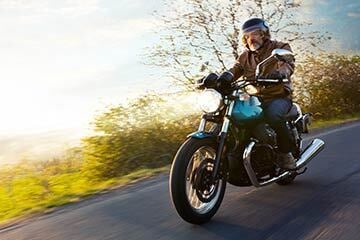While you see them less nowadays, sidecars are still a useful addition to a motorbike. Whether it's for passengers or luggage, these one-wheeled wonders create handy extra space for your bike. Here's everything you need to know, including how to insure your sidecar.

What is a sidecar?
Sidecars are a one-wheeled motorcycle attachment, effectively turning your bike into a three-wheeler. This old-school modification is incredibly useful for transporting an additional passenger - or passengers in some cases - or extra cargo. Or your pet!
Sidecars were first dreamt up at the end of the 19th century, when a French army officer designed one for a competition in a newspaper. They were first produced in the UK in the early 20th century.
Did you know?: Luxury car brand Jaguar began life as a sidecar manufacturer in 1922.
Watsonian, one of the oldest sidecar manufacturers, still exists as Watsonian Squire. Other notable modern-day manufacturers include American brands Champion Sidecars and Cozy Rockets, and Russian manufacturer Ural Motorcycles.
In addition to everyday use, sidecars were used by the military in World War I and II. They were also adapted for sidecar racing events in the 1950s, becoming longer, lower to the ground and faster. Nowadays sidecar racing is incredibly popular, with numerous categories of sidecar road racing.
How much more is motorbike insurance with a sidecar?
When you apply for motorbike insurance, a sidecar is classed as an accessory. But while this is a straightforward process, it's worth noting that not all motorbike insurers will cover them.
In addition, having a sidecar increases the risk of an accident. As such, it's likely that the price of your motorcycle insurance will go up. But the cost of cover is affected by numerous factors, so adding a sidecar doesn't have to be expensive. Read our top tips for getting cheaper motorbike insurance.
How can I find the right sidecar insurance?
The best way to find the right sidecar insurance for you is to shop around. Using comparison sites can help you see a range of quotes for your sidecar. Then you can compare these side-by-side, considering both price and the level of cover offered.
Typically you don't buy sidecar insurance as such. Rather, you add your sidecar as an accessory when insuring your main bike. You'll be asked for the make and model of the sidecar, plus its value. Then this'll be taken into account by the insurer when giving you a quote for overall cover.
Before you commit, always check that what's covered is right for your circumstances, taking note of any possible exclusions.
Types of sidecar insurance?
Your sidecar is normally covered as an accessory on your motorcycle insurance. There are a few different levels of cover to consider, offering varying degrees of protection.
Third-party only (TPO)
Sometimes referred to as liability coverage, this essentially covers your back if you injure any third parties or damage their property. But if you're involved in a collision that's your fault, you won't be covered for damage to your bike or sidecar, or injury to yourself.
Third-party, fire and theft
This offers the same protection as TPO, but you're also covered if your bike or sidecar is damaged by fire. It also protects you financially if your bike is stolen, or damaged in an attempted theft.
Comprehensive insurance
Fully comprehensive policies cover you for all of the above, but also protect you if your bike or sidecar is damaged in a collision that's your fault. It will also pay out if you sustain an injury yourself.
Custom coverage options
You may be able to find insurers and brokers who offer bespoke policies specifically catered to your motorcycle and sidecar. It's always worth shopping around to find the motorbike insurance which best suits your needs. Now we'll look at insurance for mods and self-built or kit sidecars.
Sidecar modifications
Modifications to sidecars - or to the sidecar and bike combo (known as an 'outfit') - are common. There are numerous ways you can improve general safety and performance with mods. For example, you can create extra power by adjusting the gears, or add leading link forks to improve the handling.
If you modify your motorbike frame to fit the sidecar, you'll need to inform the Driver and Vehicle Standards Agency (DVSA). Even though many modifications are made with improving safety in mind, the DVSA will nonetheless need to know that the vehicle meets safety standards.
Plus you'll need to tell your insurance provider, who'll need to price your motorbike insurance accordingly.
Can I ride with a self-built sidecar?
Again, if you have a self-built or construction kit sidecar, you'll need to tell the DVSA. It may be that, if the outfit has been altered sufficiently, it'll need to be re-registered.
If this is the case, you'll need to use the government's motorcycle single vehicle approval (MSVA) scheme to ensure it's safe and roadworthy. This involves paying the DVSA for an inspection. Provided it passes, you’ll also get a new vehicle identification number (VIN), logbook and Q-plates.
Then you'll need insurance before you can take it on the road. Your choice of insurers could be slim if you've got a self-built or kit sidecar. This is because kits may use non-standard or aftermarket parts, meaning you may need specialist cover. But don't worry - there are specialist insurance providers out there who should be able to arrange cover for your outfit.
How to ride a motorcycle with a sidecar safely
If you've never ridden a motorbike with a sidecar before, it's a good idea to get a bit of practice in. It's perfectly safe for both the rider and passenger, but takes a little getting used to.
One of the most important things is ensuring the sidecar is fitted correctly. It may be worth seeking help from a qualified mechanic or experienced outfit rider to check it's all correct. Get them to run you through the necessary pre-ride checks too.
Do I need lessons for riding with a sidecar?
While not compulsory, it's not a bad idea to get extra lessons for riding with a sidecar if it makes you feel more comfortable.
The additional weight does affect the way you ride. This usually makes you more stable when going straight, but turning and cornering can be tricky to master. For this reason, you may benefit from lessons. Or simply spend some time practising in a large, quiet area such as a big car park or industrial estate.
Does the passenger have to wear a helmet?
As with a pillion, the sidecar passenger is the responsibility of the rider. You should warn them to stay in the sidecar at all times, and not do anything which might distract you while riding.
As for safety gear, unlike many countries in Europe, it's not a legal requirement for a passenger to wear a helmet in the UK. But it's nonetheless advisable, to ensure your passenger's safety.
Motorbike and sidecar law
Sidecars are considered to be motorbike accessories, rather than vehicles in themselves. Nonetheless, they need to conform to safety standards, and certain motorcycle laws do apply to them.
Sidecars must be on the left
Unless your motorbike was registered before 01 September 1981, or outside of the UK, sidecars must be fitted to the left.
You need to get an MOT when it's fitted
Even if you still have a current MOT for your bike on its own, you'll need to get a new MOT once the sidecar is fitted.
You need to pass your CBT
You need to pass compulsory basic training (CBT) before riding with a sidecar. This is a course that you usually need to take before riding a motorbike or moped on the road. There's no test, so you can't pass or fail. But if you need a valid CBT certificate to ride a bike and don't have one, you can be fined up to £1,000 and get 6 points on your licence.
UK law requires all motorbike riders to wear a helmet. Passengers in your sidecar aren't legally required to wear one themselves, but it is advisable to do so.
What license do I need to drive a motorbike with a sidecar?
As you might expect, you need the right kind of motorbike licence to ride a bike with a sidecar. In this case, you need a full (Cat A) motorcycle licence - not a car or tricycle licence.
If you have a restricted licence, you should check the correct power-to-weight ratios at GOV.UK.







